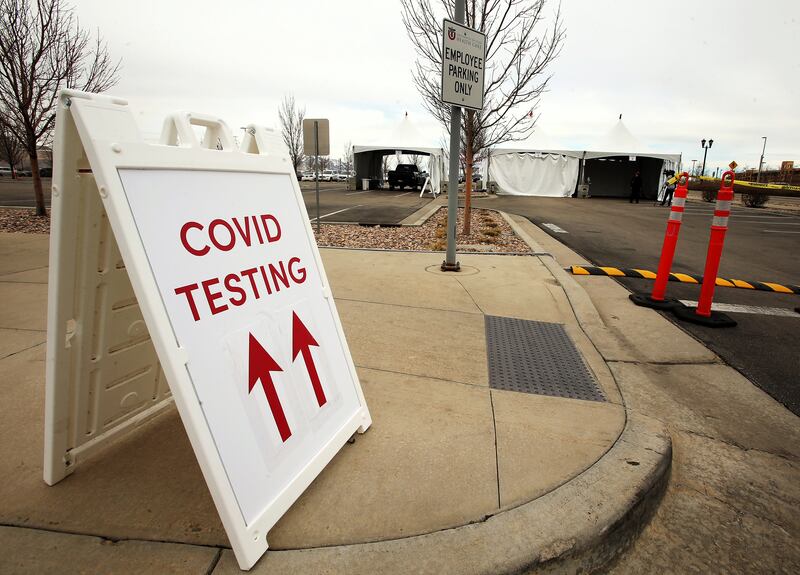SALT LAKE CITY — A panel of appointed experts has recommended that Utah’s governor remove some restrictions for the public and for businesses amid continued spread of the novel coronavirus.
“I wholeheartedly believe that this action can be taken because the citizens of the state of Utah are doing a great job with hygiene and social distancing in order to flatten the curve of the spread of the virus,” said retired Maj. Gen. Jefferson Burton, who was appointed as a chairman of the Utah Public Health and Economic Emergency Commission and acting executive director of the Utah Department of Health last week.
The group believes the state will be safe to move from red- to orange-level guidelines outlined in the Utah Leads Together plan, which means restaurants could be open for dine-in patronage with special precautions, among other things.
It would still call for widespread use of face coverings and limited in-person interactions and travel, schools would still be closed and businesses would need to check employees for symptoms regularly.
Sen. Dan Hemmert, R-Orem, who also chairs the commission, said the recommendations they’ve made “will keep Utahns safe and healthy as we transition to safely opening up the economy.”
Utah Gov. Gary Herbert has until April 30 to decide whether to adopt the recommendations or provide details on why he won’t.
“There’s much reason to be optimistic,” Herbert said during Thursday’s daily briefing at the state Capitol. “We have the most comprehensive plan of anywhere in the nation. ... Our plan is working.”
On Thursday, the Utah Department of Health reported 3,612 confirmed cases of COVID-19 in Utah — an increase of 167 new cases. Of those, 301 people in Utah have now been hospitalized with the highly contagious respiratory virus, and the agency reported one additional death, a man over age 85 who lived in a long-term care facility in Salt Lake County prior to being hospitalized with COVID-19.
That brings the number of coronavirus deaths in Utah to 35.
Utah epidemiologist Dr. Angela Dunn said traffic patterns and other indicators are showing that Utahns are social distancing.
“People are moving around less and intending to stay closer to home,” she said, adding that it is helping to flatten the number of potential infections throughout the state.
Within the first 24 hours of releasing its new smartphone application on Wednesday, Healthy Together has had 15,000 people join.
“The more people who participate, the better it is for all of us,” Herbert said. But, he noted that a significant group in Utah is not represented well enough in the state and may not be getting the right information about where the state stands in its fight against the latest coronavirus.
On Thursday, the governor announced a new subcommittee of the state’s COVID-19 task force that will help Utah’s minority and multicultural populations, “to make sure our marginalized communities are not disproportionately harmed,” said Nubia Peña, director at the Utah Division of Multicultural Affairs, who has been asked to help lead the new group.
“While the COVID-19 virus can infect anyone ... data is showing a greater impact on minorities or low-income communities,” said Byron Russell, of the Utah Multicultural Commission, who will assist in leading the Multicultural Task Force Subcommittee.
Peña said their survey data shows that Utah’s minorities are worried about their basic needs amid the coronavirus outbreak and resulting pandemic, but also face barriers to quality health care, don’t have access to computers and technology and are reporting increased cases of domestic abuse.
“These are uncertain and trying times for everybody,” Herbert said. “All Utahns are feeling the pinch.”
Dunn also said 45 people in correctional facilities in Salt Lake County have tested positive with COVID-19 — including 18 staff members and 27 inmates in the Salt Lake County Jail or halfway houses. The local health department is working to ensure that anyone newly incarcerated is quarantined 14 days and all inmates are monitored twice a day for signs and symptoms of the illness. She said the jail employees are using personal protective equipment and they are cleaning and disinfecting surfaces more often, as directed by the health department.
Local store shelves are also showing signs of stabilization. Hemmert said real-time data shows “the state is ready for this next phase.”
During Thursday’s briefing, however, Herbert said “recovery mode” is “a few weeks, or a couple of months away.”
A breakdown of Utah COVID-19 cases, hospitalizations and deaths by health district:
- Salt Lake County, 1,889; 165 hospitalized; 20 deaths.
- Utah County, 611; 33 hospitalized; 6 deaths.
- Summit County, 343; 31 hospitalized; 0 deaths.
- Davis County, 254; 21 hospitalized; 2 deaths.
- Weber-Morgan, 136; 15 hospitalized; 2 deaths.
- Wasatch County, 127; 6 hospitalized; 1 death.
- Southwest Utah, 76; 9 hospitalized; 1 death.
- Bear River, 56; 10 hospitalized; 1 death.
- Tooele County, 46; 4 hospitalized; 0 deaths.
- San Juan County, 37; 5 hospitalized; 2 deaths.
- Central Utah, 21; 1 hospitalized; 0 deaths.
- TriCounty (Uinta Basin), 9; 1 hospitalized; 0 deaths.
- Southeast Utah, 7; 0 hospitalized; 0 deaths.


